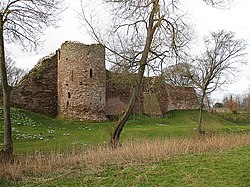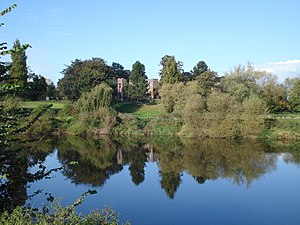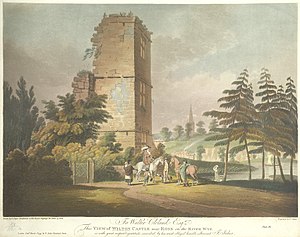Wilton Castle: Difference between revisions
Created page with "{{Infobox castle |name=Wilton Castle |county=Herefordshire |picture=Winter view of Wilton Castle - geograph.org.uk - 1169638.jpg |picture caption=Wilton Castle |os grid ref=SO..." |
No edit summary |
||
| (2 intermediate revisions by the same user not shown) | |||
| Line 1: | Line 1: | ||
{{distinguish|Wilton Castle, Yorkshire}} | |||
{{Infobox castle | {{Infobox castle | ||
|name=Wilton Castle | |name=Wilton Castle | ||
| Line 14: | Line 15: | ||
|battles= | |battles= | ||
|events= | |events= | ||
|garden=yes | |||
}} | }} | ||
'''Wilton Castle''' is a 12th-century Norman castle in south-eastern [[Herefordshire]], | '''Wilton Castle''' is a 12th-century Norman castle in south-eastern [[Herefordshire]], at [[Wilton, Herefordshire|Wilton]] beside the [[River Wye]] and adjacent to the town of [[Ross-on-Wye]]. The castle is named after the manor associated with it. | ||
[[File:Wilton Castle - geograph.org.uk - 619702.jpg|thumb|Wilton Castle]] | [[File:Wilton Castle - geograph.org.uk - 619702.jpg|thumb|Wilton Castle]] | ||
[[File:View of Wilton Castle by E. Dayes 1797.jpg|thumb|A painting of Wilton Castle by E. Dayes, 1797]] | [[File:View of Wilton Castle by E. Dayes 1797.jpg|thumb|A painting of Wilton Castle by E. Dayes, 1797]] | ||
This castle is still standing mostly to battlement height, and remains a monument to its former lords. The Longchamps of Wilton in their time provided Bailiffs of Normandy, Chancellors of England, sheriffs of Hereford and the Welsh Marches and enemies of King John. | This castle was destroyed as a defensible place in the Civil War but is still standing mostly to battlement height, and remains a monument to its former lords. The Longchamps of Wilton in their time provided Bailiffs of Normandy, Chancellors of England, sheriffs of Hereford and the Welsh Marches and enemies of King John. | ||
The Longchamps were succeeded by the families of De Cantilupe and De Grey who between them built up a powerbase in Wales and the Marches. Matilda de Grey, née de Cantilupe, stood up in court in 1292 and lied through her teeth to King Edward I of England that the castle had been built by her Longchamp ancestors in the days of Edward the Confessor (1042–66). In fact, the castle could not have been built before 1154 and certainly the 'barony' never held the Marcher Lord rights Lady Matilda claimed for it. | The Longchamps were succeeded by the families of De Cantilupe and De Grey who between them built up a powerbase in Wales and the Marches. Matilda de Grey, née de Cantilupe, stood up in court in 1292 and lied through her teeth to King Edward I of England that the castle had been built by her Longchamp ancestors in the days of Edward the Confessor (1042–66). In fact, the castle could not have been built before 1154 and certainly the 'barony' never held the Marcher Lord rights Lady Matilda claimed for it. | ||
| Line 29: | Line 31: | ||
==Outside links== | ==Outside links== | ||
{{commons}} | {{commons}} | ||
*[http://www.ross-on-wye.com/index.php?page=ross_605-Wilton_Castle Ross-on-Wye - Wilton Castle] | *[http://www.ross-on-wye.com/index.php?page=ross_605-Wilton_Castle Ross-on-Wye - Wilton Castle] | ||
*[http://www.wyenot.com/news/2005-03-01-1.htm Wilton Castle] on ''WyeNot'' | *[http://www.wyenot.com/news/2005-03-01-1.htm Wilton Castle] on ''WyeNot'' | ||
Latest revision as of 23:54, 14 November 2019
- Not to be confused with Wilton Castle, Yorkshire
| Wilton Castle | |
|
Herefordshire | |
|---|---|
 Wilton Castle | |
| Location | |
| Grid reference: | SO59032439 |
| Location: | 51°54’60"N, 2°35’50"W |
| History | |
| Information | |
| Condition: | Still standing to battlement height |
Wilton Castle is a 12th-century Norman castle in south-eastern Herefordshire, at Wilton beside the River Wye and adjacent to the town of Ross-on-Wye. The castle is named after the manor associated with it.


This castle was destroyed as a defensible place in the Civil War but is still standing mostly to battlement height, and remains a monument to its former lords. The Longchamps of Wilton in their time provided Bailiffs of Normandy, Chancellors of England, sheriffs of Hereford and the Welsh Marches and enemies of King John.
The Longchamps were succeeded by the families of De Cantilupe and De Grey who between them built up a powerbase in Wales and the Marches. Matilda de Grey, née de Cantilupe, stood up in court in 1292 and lied through her teeth to King Edward I of England that the castle had been built by her Longchamp ancestors in the days of Edward the Confessor (1042–66). In fact, the castle could not have been built before 1154 and certainly the 'barony' never held the Marcher Lord rights Lady Matilda claimed for it.
The castle was primarily associated with a branch of the Norman-descended family of Grey, the Barons Grey of Wilton, a prominent dynasty of Norman Marcher Lords in the Welsh Marches, who held it from 1308 or before. The castle passed from the family when William Grey was captured by the French at the end of the defence of Guînes in 1557, and was forced to sell the castle to raise funds for his ransom.[1]
The castle was finally destroyed in the Civil War, a period that saw skirmishes and sieges locally at Goodrich Castle, Ruardyn Castle and Raglan Castle.
Outside links
| ("Wikimedia Commons" has material about Wilton Castle) |
References
- ↑ Grey, William (d.1562) in the Dictionary of National Biography Volume 23; pages 213, 215
- Remfry, P.M.: 'Wilton Castle, 1066 to 1646' ISBN 1-899376-35-6
- Hart, R.A.: 'A History of the Manor of Wilton and the Parish of Bridstow, Herefordshire' (Ross-on-Wye and District Civic Society, 1994)
